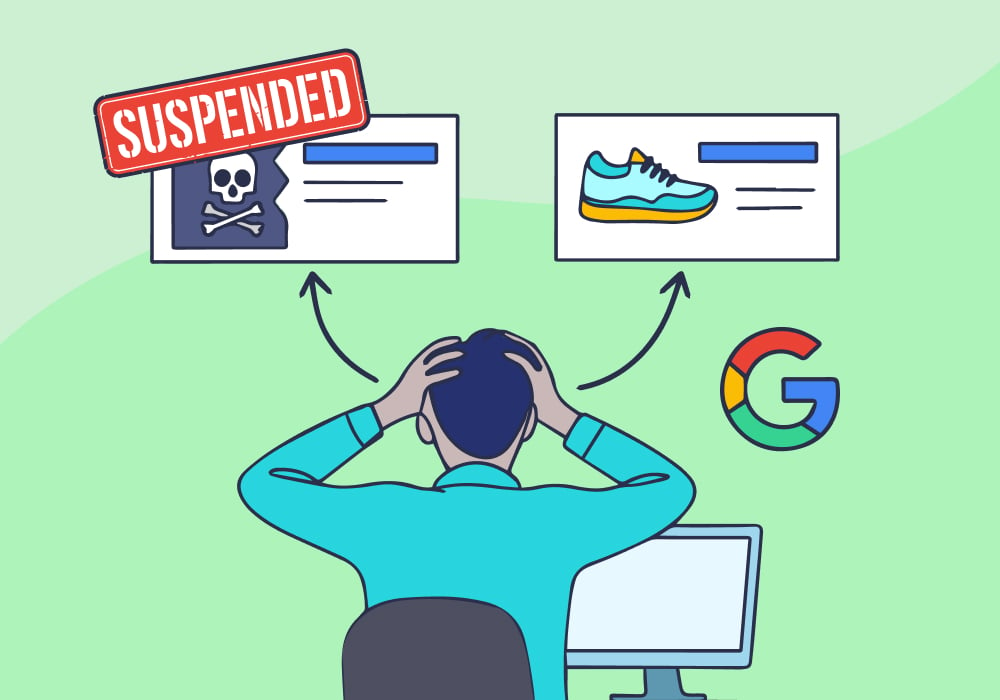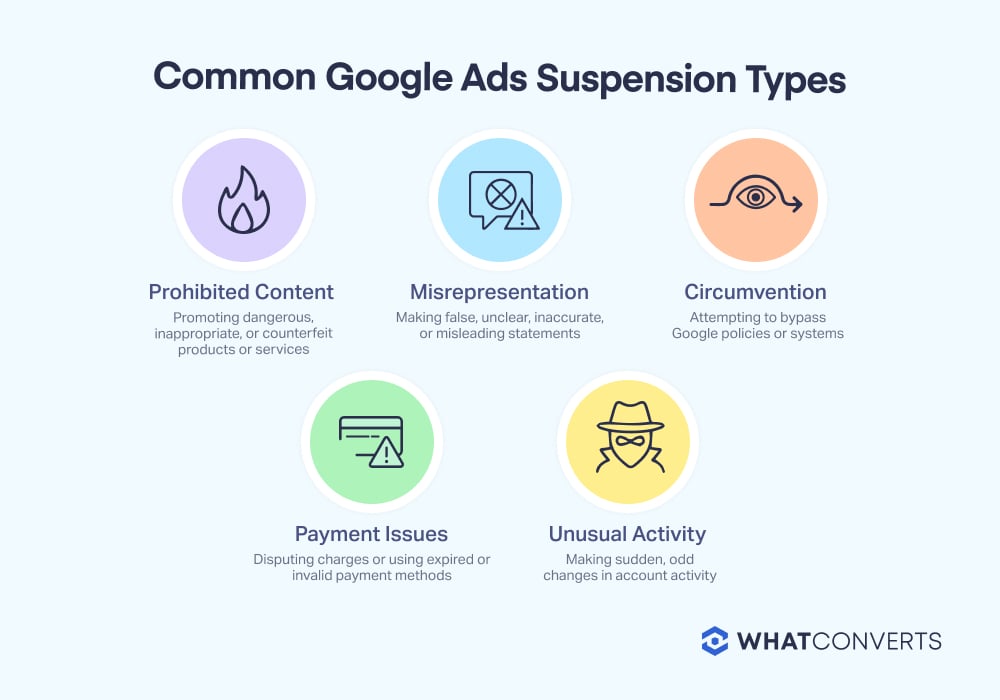
There are few things worse for a PPC marketer than logging into your Google Ads account only to be greeted with the dreaded “account suspended” message. Suddenly, all of your campaigns are halted, leads stop flowing, and the clock starts ticking toward the moment your clients inevitably notice that there’s an issue and start asking what’s going on.
For businesses that rely heavily on paid search to generate leads, these suspensions can be devastating. A suspension doesn't just stop your ads; it disrupts your entire lead generation pipeline and can take days or even weeks to resolve if handled incorrectly.
The good news is that most Google Ads suspensions can be successfully appealed—and even better, they can be prevented entirely with careful account management and auditing. This guide will walk you through understanding why suspensions happen, how to get your account back online quickly, and most importantly, how to ensure your account stays in good standing.
Understanding Google Ads Suspensions
Most suspensions fall into one of three main categories:
- Policy violations
- Payment issues
- Circumvention attempts
Genuine violations are valid cause for suspension, but plenty of account suspensions are actually the result of a technical mistake.
Google relies heavily on automated systems to detect suspicious activity, and while the platform’s size makes this automation necessary, it’s common for advertisers to find themselves accidentally getting caught in these algorithmic nets. In order to prevent and resolve these suspensions, marketers need to understand how these systems work.
Why Google Suspends Accounts
Prohibited Content and Industries
You don’t need to be promoting something illegal to accidentally get flagged for prohibited content. Certain industries and topics are prohibited from Google’s platform completely, like:
- Dangerous products or services (weapons, explosives, recreational drugs)
- Products or services that enable dishonest behavior (fake documents, academic cheating services)
- Inappropriate content (adult content, profanity, hate speech)
- Counterfeit goods
Even if your business doesn’t fall into one of these categories, mentioning anything that could be misinterpreted as promoting something prohibited can still trigger a suspension. For example, a psychiatric clinic that mentions controlled substances in its ad copy might face suspension, even if they don't promote those substances for illegal recreational use.
Misrepresentation and Deceptive Practices
Google has built its entire business on its reputation for maintaining user trust, and it protects that reputation very carefully. That’s why it has very strict guidelines surrounding ads that could potentially mislead users. Common misrepresentation issues include:
- Making false claims about products or services
- Unclear or inaccurate billing terms
- Collecting user information under false pretenses
- Using misleading design elements (fake notifications, countdowns)
- Claiming unrealistic results without proper disclaimers
These guidelines are even stricter for businesses in Google’s “Your Money, Your Life” or “YMYL” industries, like healthcare, law, and financial services. But regardless of what business you’re in, it’s important to make sure that any claims you make in your ads are factually accurate and not misleading.
One way to catch potentially misleading content is by looking at ads that generate a lot of click-throughs but very few qualified leads. This can be a sign that the ad copy is misleading, and prospects are clicking the ad expecting one thing and leaving when your landing page proves to be another.
Circumvention Attempts
Google views any attempt to bypass its policies or systems as a serious violation. Circumvention includes:
- Creating multiple accounts after a suspension
- Using different payment methods to restart suspended campaigns
- Concealing website content from Google's reviewers
- Repeatedly submitting the same disapproved ads
- Using redirects to show different content to users than what was reviewed
Circumvention suspensions are often the most difficult to resolve because they damage trust with Google and may require significant changes to prove compliance.
Payment-Related Issues
Not all suspensions are related to policy violations or controversial behavior. Sometimes it’s just a simple matter of your payment not going through as expected. Common payment-related problems include:
- Repeated payment failures
- Chargebacks on Google Ads payments
- Using payment methods not owned by the account holder
- Suspicious payment patterns (potential fraud signals)
While these suspensions are typically easier to resolve than policy violations, they can still be time-consuming and cause significant disruption to your campaigns.
Unusual Account Activity
Sudden, odd changes in account behavior can trigger automatic reviews and potentially get your Google Ads suspended. Google’s systems are designed to pick up on departures from the norm or other abnormal patterns that might indicate fraudulent behavior, so maintaining consistent and predictable account activity is the best way to avoid this type of suspension.
Google looks for unusual patterns that raise suspicion, like:
- Unusually high click-through rates that may indicate click fraud
- Dramatic increases in daily budget or bidding
- Running extremely high volumes of disapproved ads
- Rapid creation of multiple campaigns that appear duplicative
One way to help prevent potentially erratic patterns and keep your ad activity stable is to switch to optimizing for leads rather than all click conversions. When Google’s algorithm adjusts to prioritize ads that get the highest click-through rates, it can wind up unintentionally bidding for the keywords that are bringing in the most spam.
By tracking which clicks came from qualified leads and sending that data back to Google as enhanced conversions, you can force the algorithm to target the keywords that are bringing in the highest number of “approved” clicks from real, qualified human leads. This will help prevent volatile patterns in keyword bidding or click-throughs that can be triggered by bots and spam.
Read More: Agency Wins 12x ROAS and 57% Revenue Boost by Qualifying Leads [Case Study]
Step-by-Step Process to Remove a Suspension
Having your account suspended can feel overwhelming, especially when you have clients counting on you to deliver results. If you find yourself in this situation, follow these steps:
1. Diagnose the Exact Cause
The first step is to gather as much information as you can about what caused your Google Ads to be suspended in the first place.
Start by carefully reviewing the suspension email and any related notifications in your account. Note the policy category mentioned and what examples Google provides, if any. If the issue is related to something specific, Google may cite a specific ad, keyword, or landing page that triggered the suspension.
With this information, do a thorough overview of your account to compare your content against Google’s policies, especially those mentioned in your suspension email. Review your ad copy, landing page content and functionality, targeting settings, and the details of your ad offers. Document everything you find—this will be essential to putting together an effective appeal.
2. Fix the Problem
It should go without saying, but we’re saying it anyway: if you find that the suspension is related to a legitimate issue, fix the problem before you appeal the suspension. Update your payment method, remove your problematic ad, update your landing page—do whatever you need to do to bring your account back into compliance.
Go beyond just the instances cited by Google in your suspension email. If you’ve discovered an issue with your ad copy that applies across multiple campaigns, make sure you fix it across all of your content, even if they weren’t all flagged. A comprehensive fix demonstrates your commitment to compliance and reduces the likelihood of immediate re-suspension.
3. Write Your Appeal
Once you’ve identified the issue and gathered your supporting documentation, you’ll need to appeal your suspension. You can do this by filling out a form that you can find by clicking the “Contact Us” link in your suspension notification.
A good appeal includes:
- A clear acknowledgment of the issue
- An explanation of the changes you’ve made to fix the problem
- Documentation that supports your case (screenshots of changes, financial documentation, etc.)
- An assertion of your commitment to ongoing compliance with Google's policies
Be concise but thorough, and maintain a professional tone. Remember that real people will review your appeal, so clarity and completeness matter. If you're dealing with a complex situation, consider creating a simple document that outlines the issues and resolutions, which you can reference in your appeal.
When submitting documentation, quality matters more than quantity. A few well-chosen, clearly labeled pieces of evidence will be more effective than overwhelming reviewers with excessive documentation.
4. Escalate if Necessary
If your standard appeal isn’t successful but you’re certain that your account isn’t violating policies, there are a number of ways that you can escalate the issue:
- Request a call from a Google Ads specialist through the Help Center
- Reach out to your Google Ads representative, if you have one
- Post in the Google Ads Community Forum, where Google employees sometimes monitor and respond
For particularly complex or high-value accounts, consider consulting with an agency specializing in Google Ads. These specialists often have experience with similar cases and may even have established relationships with Google representatives, which can be helpful for solving the issue and possibly expediting your reinstatement.
Interim Planning: Doing Damage Control Until Your Account is Reinstated
It typically takes 3-7 business days to get a response to your initial suspension appeal, and complex cases can take even longer. During this waiting period, do not create any new Google Ads accounts. This can get flagged as an attempt at circumventing Google’s policies, which will only dig you further into your account suspension hole.
Use this time to improve your account structure, refine your targeting, and update your creative assets. Don’t try to hide what’s going on from your clients or upper-level stakeholders. Instead, take a proactive approach to breaking the bad news, and be sure to mention that you’re aware of the issue, have a timeline for fixing it, and are implementing changes to ensure it doesn’t happen again. Confronting problems confidently and transparently gives you an opportunity to turn a negative situation into a trust-builder.
Building a Suspension-Proof Account
Resolving suspensions is great, but preventing them is better. By proactively implementing systems and quality standards, you can ensure your account stays well within the safe zone of policy compliance and prevent avoidable Google Ads suspensions.
One of the most effective prevention strategies to avoid getting flagged by these systems is to implement robust lead quality filtering through your tracking system.
With lead tracking, you can implement quality-based filtering before sending conversion signals back to Google Ads. This helps prevent problematic optimization patterns that might eventually trigger account reviews:
- Send only qualified lead conversions back to Google Ads, avoiding optimization toward spam or unqualified traffic
- Prevent automated bidding from increasing spend on keywords that drive low-quality traffic
- Maintain more consistent conversion patterns, avoiding suspicious spikes that might trigger automated reviews
By controlling which conversions influence your bidding algorithms, you create more stable, quality-focused campaigns that are less likely to trigger automated suspension reviews.
Ready to start tracking leads and improving your ad traffic quality?
Start your free 14-day trial of WhatConverts today or book a demo with a product expert to see how we help prove and grow your ROI.
Get a FREE presentation of WhatConverts
One of our marketing experts will give you a full presentation of how WhatConverts can help you grow your business.
Schedule a Demo
Grow your business with WhatConverts






